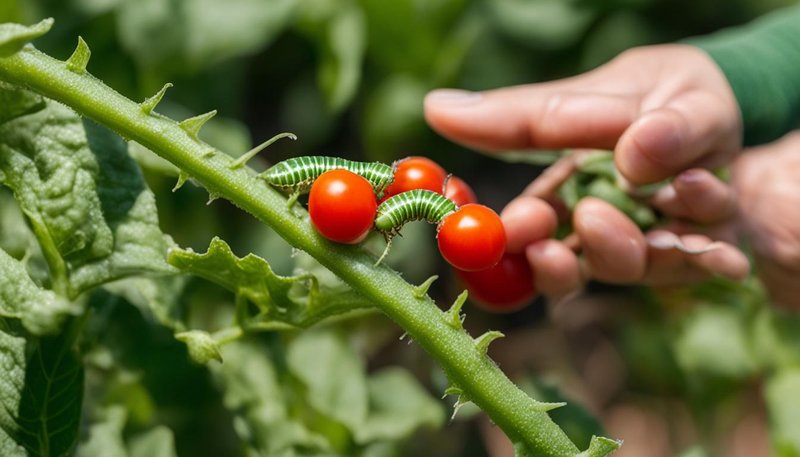
So how do you go about handpicking hornworms without accidentally damaging your plants? It’s all about technique. If you’ve ever taken care of plants, you know that even the gentlest touch can be too much for delicate stems and leaves. But with a little practice and the right mindset, you can become a pro at removing these invaders while keeping your plants healthy and thriving. Let me guide you through the steps, tips, and tricks that can make this process as smooth as possible.
Understanding Hornworms: What They Are and Why They Matter
Before jumping into the handpicking process, it’s important to know what hornworms actually are. These pests are typically around 3-4 inches long, with a prominent horn-like structure on their rear. They’re masters at camouflage, blending seamlessly into the leaves of plants. You might be wondering why these guys are such a big deal. Well, they can munch through a plant in a matter of days, leading to stunted growth, wilting, and even death of your precious greens.
Identifying hornworms is the first step in managing their population. Look for their droppings—small, dark pellets that can litter the ground beneath your plants. If you find any, it’s a good indicator that these critters are around. Additionally, check your plants regularly for signs of nibbling. The sooner you spot these guys, the better your chances of saving your plants from further damage.
Why Handpicking Is Effective
You might be thinking, “Why should I handpick hornworms when I could just spray pesticides?” Here’s the thing: while pesticides might seem like a quick fix, they can harm beneficial insects, the environment, and even your health. Handpicking is a more sustainable and safe approach to pest control. Plus, it gives you a chance to enjoy your garden up close.
When you handpick hornworms, you can do it at your own pace. You get to know your plants intimately and spot other potential issues, like disease or other pests. And hey, it can even be a calming activity—almost like a form of meditation where you can connect with nature.
Essential Tools for Handpicking
Having the right tools can make a world of difference when it comes to handpicking hornworms. You don’t need anything fancy, just a few simple items that can help ensure you’re doing it right without damaging your plants. Here are some essentials:
- Gloves: Wearing gloves protects your hands from any potential irritants and helps you get a better grip.
- Tweezers: For those tricky-to-reach spots, tweezers can be your best friend. They allow for precision without harming surrounding leaves.
- Pail or Bag: Keep a container handy to collect the hornworms as you find them. It’s an easy way to keep track of your progress.
- Hand Pruners: If you see a heavily infested branch, pruning it away can help salvage the rest of the plant.
These tools help you be more efficient and gentle as you hunt for those pesky pests. Plus, having a designated container to collect them makes it easy to keep your picking session organized.
Time Your Picking: When Is the Best Time?
Timing is everything, and that holds true for handpicking hornworms. The best time to search for these caterpillars is during the early morning or late afternoon. Why? Well, hornworms are more active at night and tend to hide during the day. By searching in the cooler hours, you can catch them when they’re less likely to notice you—and they’re more likely to be out in the open.
Also, regularly checking your plants every few days can help you stay ahead of any infestations. You might find it helpful to set a routine—like checking your plants every Saturday morning with your trusty gloves and container in hand. This way, you’ll become familiar with your plants’ growth patterns and be more aware of any issues before they escalate.
How to Handpick Hornworms Without Damaging Plants
Now, let’s get into the nitty-gritty of handpicking hornworms without causing chaos among your plants. Here’s a step-by-step approach to make your journey easier:
1. Inspect the Plants: Start by closely examining the leaves and stems. Look for any holes or chew marks. Pay special attention to the undersides of leaves, where hornworms often hide.
2. Gently Move Leaves: Use your hands or tweezers to carefully part the leaves. Be gentle—plants can be delicate, and a rough touch can cause bruising or breakage.
3. Pick the Hornworms: Once you spot a hornworm, use your fingers or tweezers to grab it. Make sure to get as close to the body as possible to avoid damaging surrounding foliage.
4. Drop Them in Your Container: Once you’ve got a hold of a hornworm, drop it into your container. If you notice multiple hornworms on a single plant, it’s a good idea to check the entire plant to ensure you’re removing all of them.
5. Dispose of Them Safely: After your picking session, dispose of the hornworms away from your garden. You could throw them in a compost bin or even feed them to chickens if you have any. This prevents them from returning to your plants.
Preventing Future Infestations
After dealing with hornworms, you might be wondering how to prevent them from returning. Here are some proactive steps:
- Plant Companion Plants: Certain plants like basil or marigolds can repel hornworms and other pests.
- Encourage Beneficial Insects: Ladybugs and lacewings are natural predators of caterpillars. You can attract them by planting flowers that they love.
- Regular Maintenance: Keep your garden clean. Remove any dead leaves or plant debris where hornworms might lay eggs.
Taking these preventive measures can keep your garden healthier and reduce the chances of hornworm infestations in the future.
Handpicking hornworms might seem daunting at first, but with a little practice, it can become a rewarding part of your gardening routine. You’re not just protecting your plants; you’re building a deeper connection with your garden. Think of it as a mini-adventure every time you step outside. Plus, you’ll feel a sense of accomplishment after each successful hunt.
As you become more familiar with your plants and the little critters that inhabit them, you’ll find that patience and persistence pay off. So grab your gloves, pick up those tweezers, and get ready to discover the amazing world of your garden—all while keeping it healthy and vibrant!

